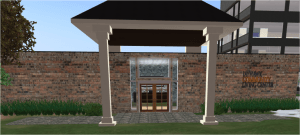By Sian Claire Owen
 Health informatics students must develop workflow modeling skills in order to create efficient health information systems. Paper-based workflow systems can be difficult for the student to visualize, therefore Juliana Brixey from the University of Kansas Nursing School, US, developed a virtual environment in which students can use workflow modeling simulations.
Health informatics students must develop workflow modeling skills in order to create efficient health information systems. Paper-based workflow systems can be difficult for the student to visualize, therefore Juliana Brixey from the University of Kansas Nursing School, US, developed a virtual environment in which students can use workflow modeling simulations.
“If you send students out into the work place, you, as the instructor, probably won’t be there. So you don’t know whether their actual capture is correct,” said Juliana Brixey. “So each student would return [from the work place] with some variation on the work flow.”
In order to address this issue, Brixey and her colleague, Judith J Warren decided to explore Second Life as a platform for creating workflow modeling simulations, and they chose to focus on a specific problem that commonly occurs in real life.
“Over the semester, the students were asked to build a health information system, and the primary function is to capture data about risk for falling,” she said. “Falls are a big problem in hospitals, so we thought we’d take a real life application and model that.”
Students would create an avatar and gain access to the Community Living Centre in Second Life. “Students and faculty members come to the island and explore that area,” she explained. “We do a walk-through on a paper-based system as it is in the current state, and then their future state is to design the system for an electronic database.”
You can watch the walk through example in the video below (reproduced with kind permission of Juliana Brixey, University of Kansas Nursing School, USA).
https://virtualpatients.eu/wp-content/uploads/2010/05/Brixey_Snippits-1.mov
This case study in using virtual reality to simulate workflow models has so far been a success. “There has been a smooth integration [of Second Life] into our courses. We don’t use Second Life as just a technology on top of what we teach, it’s really a part of our coursework.”
“The first time we introduced Web 2.0 tools and technologies to our students, they thought we were crazy!” she said. “But because we don’t really focus on Second Life, but we try to make it an engaging experience, we’ve had really good buying in from the students.”
“They don’t see it as a game, or that it’s a futile assignment, because we really do have it as a real problem for them to solve.”
The success of this project means that more Second Life scenarios are in the pipeline. “We will continue to build simulations so we can model the real work and make virtual worlds for students to come in to, so if you make mistakes in Second Life no-one gets hurt.”
You can listen to Juliana Brixey talk to eViP about workflow modeling simulations in Second Life here:
